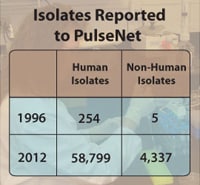PulseNet In Action

Isolates reported to PulseNet
Pulse Net was developed after the 1993 E. coli O157 outbreak from hamburgers sickened 726 people and killed 4 children. After the outbreak, more clinical labs began testing ill people for E. coli and found many more infections—revealing the problem was more widespread than originally thought. Health departments did not have data to determine which illnesses were linked by a common food source.
PulseNet solved this problem by providing the testing methods, technology, and data needed to connect illnesses to a common food source as well as other patients. PulseNet is a national network of public health and food regulatory agency laboratories that perform standardized molecular subtyping (“fingerprinting”) of foodborne disease-causing bacteria. PulseNet detects subtypes of E. coli O157 and other Shiga toxin-producing E. coli, Campylobacter jejuni, Clostridium botulinum*, Listeria monocytogenes, Salmonella, Shigella, Vibrio cholerae, and Vibrio parahaemolyticus.